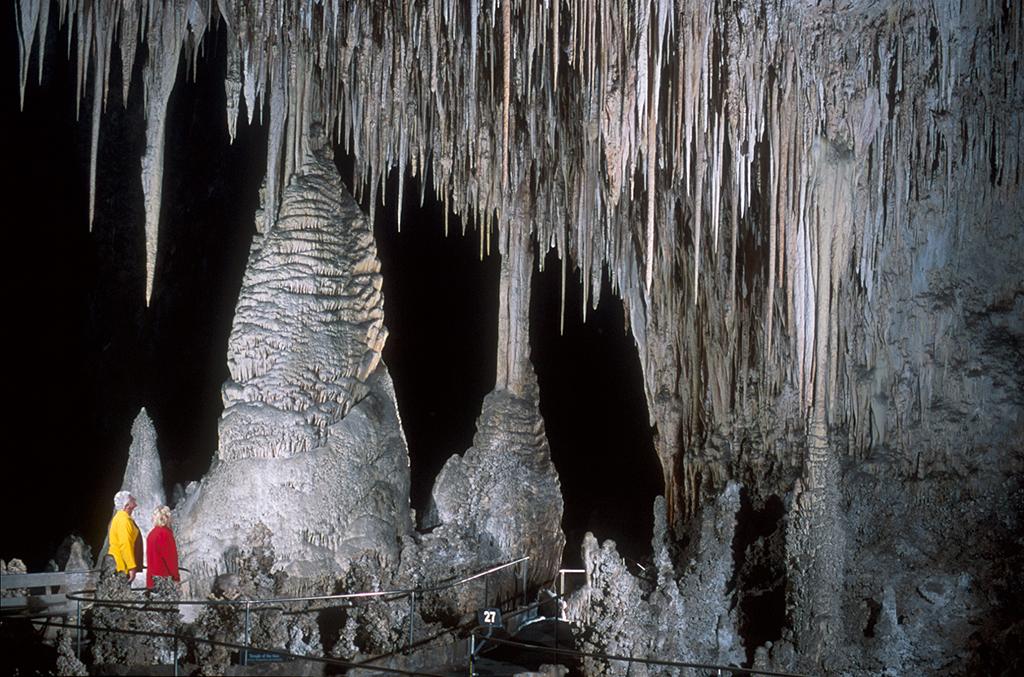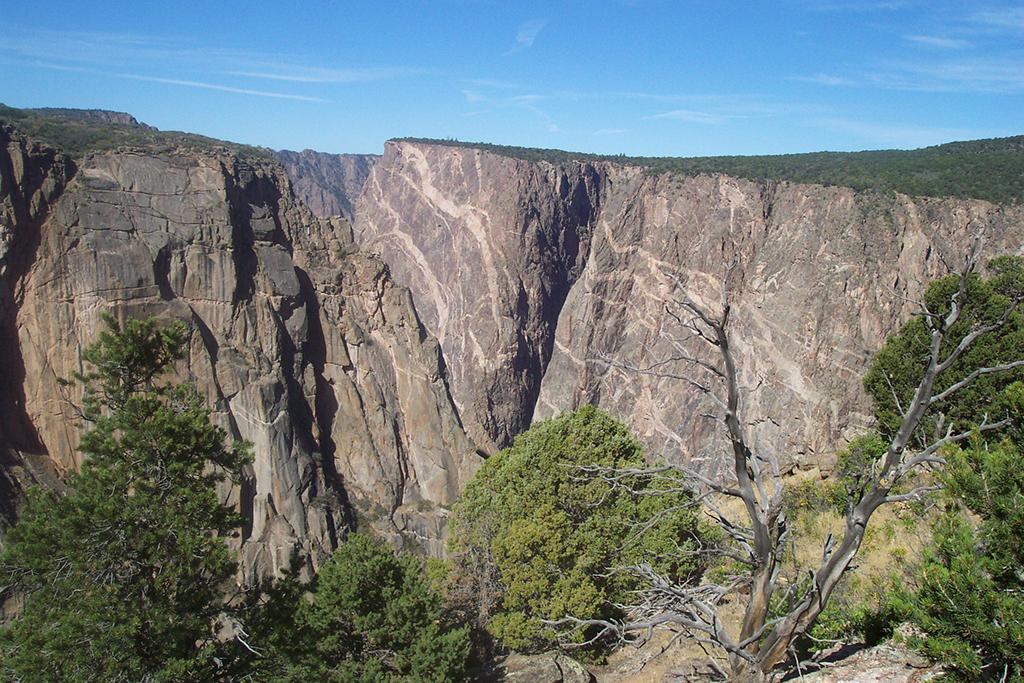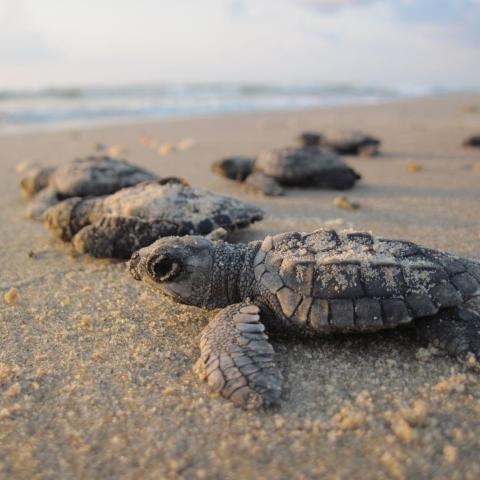
Valley and mountains, Grand Teton National Park / Rebecca Latson
I mentioned in a previous quiz that I really didn’t know as much about national parks as I thought I did. As I continue working on these quiz-and-triva pieces for the Traveler, I am learning more and more interesting tidbits about our protected lands. Here’s the latest. Test your knowledge first, before checking the answers at the bottom of the article.
1. True or False: The Tetons in Grand Teton National Park are the youngest mountains in the Rockies.
a) True
b) False

Capitol Reef color, Capitol Reef National Park / Jeff Hollett
2. True or False: Capitol Reef National Park features a huge ancient reef.
a) True
b) False

Temple of the Sun, Carlsbad Caverns National Park / NPS-Peter Jones
3. True or False: companies used to collect guano (poop) left by the bats living in Carlsbad Caverns National Park to sell as fertilizer.
a) True
b) False

Sunset at Great Sand Dunes National Park / Thomas Elliot
4. Great Sand Dunes National Park has how many insect species native only to this park?
a) 3
b) 7
c) 15
d) 25
5. Which national park is home to the most species of cactus?

Painted Wall, Black Canyon of the Gunnison National Park / National Park Service
6. Through erosion, Black Canyon in Black Canyon of the Gunnison National Park has revealed gneiss and schist metamorphic rocks that date back more than ____ years.
a) 1.7 thousand
b) 1.7 hundred thousand
c) 1.7 million
d) 1.7 billion

A view of Pola Islands from Tutuila Rain Forest, National Park of American Samoa / National Park Service
7. National Park of American Samoa is comprised of ____
a) three volcanic islands
b) one large volcanic island and three smaller atolls
c) four rock islands
d) two islands

Fort Jefferson from the air, Dry Tortugas National Park / National Park Service
8. Which bird finds its only regular nesting site on a part of Dry Tortugas National Park?
a) Blue-Footed Booby
b) Sooty Tern
c) Frigatebird
d) Brown Noddy
9. True or False: the first Civilian Conservation Corps (CCC) camps in a national park were in Shenandoah National Park.
a) True
b) False

Fireflies, Great Smoky Mountains National Park / Niemand fur Polyphemus
10. The time span between late May to mid-June is the ideal time to view the synchronous fireflies in Great Smoky Mountains National Park. How many species of fireflies live in this national park?
a) 5
b) 9
c) 19
d) 23
And now, here’s a little bit of trivia for you

Deer in the maritime forest, Cumberland Island National Seashore / National Park Service
At Cumberland Island National Seashore, “… you are greeted by the twisting and turning branches of a vast forest of live oak trees. These dense collections of live oaks are part of a major ecosystem called the maritime forest. Maritime forests are surrounded by dunes on one side, and salt marsh on the other, and act as a stabilizing force for the shoreline. Aside from aiding in stabilization, the maritime forest also acts as a protective barrier for the salt marsh ecosystem.
Forests have three different levels: the canopy, the understory, and the ground floor. Each level is home to different plants and animals that are adapted to survive there. In a maritime forest, plants have to adapt to constant exposure to salty conditions.” To read more about this maritime forest, click here.

Bee in the ohia blossom, Hawai'i Volcanoes National Park / Rebecca Latson
Because of genetic isolation, Hawaii and Hawai’i Volcanoes National Park are home to some remarkably interesting insects, including carnivorous pug moth caterpillars (Eupithecia spp). They’ll eat other insects, including ones as large as wasps, by perching on a plant, waiting for an insect to come along. and then, when tiny hairs on the caterpillar are activated by an insect landing on them, they spring out to catch the insect for a tasty meal. To read more about the specialized insects in the park and on the island, click here.

Silversword plant, Haleakala National Park / Werner Bayer
Let’s stay a little longer on Hawaii and learn about the Haleakala silversword that lives on Haleakalā crater in Haleakalā National Park. This plant is specially adapted to live in harsh and dry environments, like a volcano crater. The lower part of the plant has fleshy leaves with silver hairs that protect the plant from the high-altitude (>10,000 feet) light and heat, and the leaves store extra water to help it survive the dry climate. The Haleakala silversword blooms only once in its life, maybe in 40 years, and grows a stalk up to 6 feet tall with rose-purple flowers. After the seeds are disbursed, the plant dies. So, if you see one of these amazing plants in bloom, consider yourself very lucky. To read more about silverswords, click here.
Quiz Answers
1a
The Teton range may contain some of the oldest rocks in North America (2.7 BILLION years old), but the Grand Teton Mountains are only about 10 million years old. That seems pretty mind boggling, but not compared to the Appalachian Mountains (300 million years old).
2b
Capitol Reef National Park was named “Capitol” for the white domes of Navajo Sandstone which resemble capitol building domes, and “reef” for the rocky cliffs being a barrier to travel, much like an ocean reef is a barrier to ships. What this national park really contains is a geologic monocline (called the Waterpocket Fold), which is basically a “wrinkle” in the earth extending almost 100 miles in distance.
3a
Guano mining began in 1903. If you visit Carlsbad Caverns National Park during the summer, at sundown you can actually watch 400,000 Brazilian free-tail bats fly out of the caves. That’s a lot of bats!
4b
According to the NPS site for Great Sand Dunes National Park, there are at least 7 endemic (native and restricted to a certain place) insect species found nowhere else on earth, including the Great Sand Dunes Tiger Beetle, which has a violin-shaped pattern on its back, and the Circus Beetle, which appears to stand on its head when threatened so it can release a noxious-smelling chemical toward the intruder.
5c
Big Bend National Park is home to 65 cactus species. Head out there in the spring, between late March and late April, and (depending upon the amount of previous rainfall) you’ll be treated to brilliant, saturated blooms of magenta, red, yellow, and orange on prickly pear, cholla, strawberry pitaya, eagle claw, and claret cup cactuses, to name a few.
6d
“Through incredible erosion, the Gunnison River has exposed a wide range of rock types, from 1.7 billion year old gneiss and schist to Mesozoic – Cenozoic fossiliferous sedimentary rocks and modern unconsolidated sediments.”
7a
“The park has units on three tropical islands (Tutuila, Ta’ū, and Ofu) in the Territory of American Samoa, located in the South Pacific Ocean.”
8b
According to the NPS site for Dry Tortugas National Park, “the Sooty Tern finds its only regular nesting site in the entire United States on Bush Key, adjacent to Fort Jefferson.”
9a
“Although Shenandoah National Park's official establishment was over two years in the future, Washington saw the future park's proximity and virginity as the ideal setting for the demonstration of Roosevelt's depression cures.
The President took a whirlwind tour through the Shenandoah Valley and along the developing Skyline Drive to bolster public confidence in his public works programs. Followed by "three newsreel photographers and a corps of newspaper cameramen,"3 Roosevelt ensured that the uplifting image of Shenandoah's CCC camps was flashed around the world. Shenandoah National Park, long before it was born, was officially baptized by the Civilian Conservation Corps.”
10c
There are 19 species of fireflies living in Great Smoky Mountains National Park, and each species has it’s own distinctive flash pattern with which males and females of that particular species can recognize each other. To read more about these fascinating fireflies and about bioluminescence, click here.
References
In addition to the information from the NPS.gov websites for each national park, I also used the following as references:
Emily Hoff & Maygen Keller, Scenic Science of The National Parks, Ten Speed Press, 2020
Erin McHugh, National Parks, A Kid’s Guide to America’s Parks, Monuments, and Landmarks, Black Dog & Leventhal Publishers, 2019
https://www.nps.gov/grte/learn/nature/geology.htm
https://www.nps.gov/care/learn/nature/geology.htm
https://www.nps.gov/cave/learn/news/interesting-facts-about-carlsbad-caverns.htm
https://www.nps.gov/grsa/learn/nature/insects.htm
http://www.ohranger.com/big-bend/flora-fauna
https://play.howstuffworks.com/quiz/black-canyon-national-park-quiz
https://www.nps.gov/articles/nps-geodiversity-atlas-black-canyon-of-the-gunnison.htm
https://www.nps.gov/npsa/learn/news/fact-sheet.htm




 Support Essential Coverage of Essential Places
Support Essential Coverage of Essential Places






